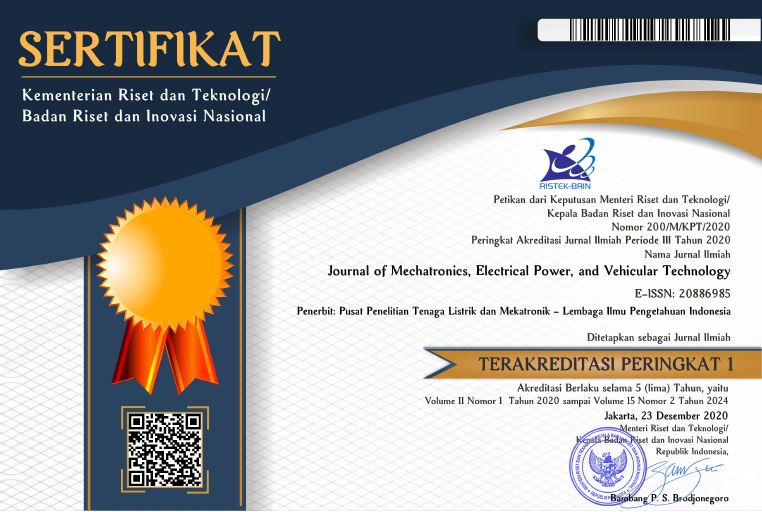Torsional strength analysis of universal joint’s ZP-11A due to yokes modification and materials
Abstract
The study examined the strength of the universal joint after it was loaded with torsion. It used different materials that can withstand tensile stress in accordance with accepted principles and made modifications to the yoke as a result of the topology optimization process. The topology optimization determined that the yoke's part needed to withstand load without changing its dimensions and minimize stress distribution. According to the results, the maximum shear stress on the spider of the original universal joint model made of JIS-SF590A steel was 84.57 MPa, the shear stress on the yoke component was 30.84 MPa, and the maximum von Mises was 341.1 MPa. As a result of using JIS-SF590A steel, yoke modification 3 has produced a reduction in shear stress of 12.97 % and a reduction in von Mises stress of 35.33 % from the original yoke. This is the most efficient design of yoke and also this modified yoke form provides a wider elevation angle and is easier to manufacture.
Keywords
Full Text:
PDFReferences
J.C. Kim, I.K. Kang, J.H. Lee, S.J. Ham, C.W. Park, and S.H. Kim, ”The maneuvering characteristics of the research vessel NARA equipped with the azimuth thruster system,” J. Korean Soc. Fish. Technol., vol. 53, no. 3, pp. 276–285, 2017.
A. Koparde, N. Mithra, and S. Ahankari, “Numerical and experimental analysis of torsional stress of traditional and modified steering yoke,”” Mater. Today Proc., vol. 46, pp.7099–7104, 2021.
N. S. Giridhar, S. Hetawal, and P. Baskar, “Finite element analysis of universal joint and propeller shaft assembly,” vol. 5, no. 5, pp. 226–229, 2013.
A. Chaban, Z. Łukasik, A. Popenda, and A. Szafraniec, “Mathematical modelling of transient processes in an asynchronous drive with a long shaft including cardan joints,” Energies, vol. 14, no. 18, 2021.
A. Lozynskyy, A. Chaban, T. Perzyński, A. Szafraniec, and L. Kasha, “Application of fractional-order calculus to improve the mathematical model of a two-mass system with a long shaft,” Energies, vol. 14, no. 7, 2021.
S. K. Bharti and A. K. Samantaray, “Resonant capture and Sommerfeld effect due to torsional vibrations in a double Cardan joint driveline,” Commun. Nonlinear Sci. Numer. Simul., vol. 97, p. 105728, 2021.
Ł. Zbigniew, C. Andriy, S. Andrzej, and Ż. Vołodymyr,” Model
matematyczny układu napędowego z silnikiem asynchronicznym i pompą pionową,” Prz. Elektrotechniczny, vol. 94, no. 1, pp. 133–138, 2018.
A. Popenda, M. Lis, M. Nowak, and K. Blecharz, “Mathematical modelling of drive system with an elastic coupling based on formal analogy between the transmission shaft and the electric transmission line,” Energies, vol. 13, no. 5, 2020.
G. Ekemb, F. Slaoui‐hasnaoui, J. Song‐manguelle, P. M. Lingom, and I. Fofana,” Instantaneous electromagnetic torque components in synchronous motors fed by load‐commutated inverters,” Energies, vol. 14, no. 11, 2021.
J. Jee, C. Kim, and Y. Kim, “Design improvement of a viscous-spring damper for controlling torsional vibration in a propulsion shafting system with an engine acceleration problem,” J. Mar. Sci. Eng., vol. 8, no. 6, 2020.
C. Wu, F. Chen, and X. Long, “The self-excited vibration induced by friction of the shaft-hull coupled system with the water-lubricated rubber bearing and its stick-slip phenomenon,” Ocean Eng., vol. 198, p. 107002, 2020.
A. Kohli, M. Hombalmath, A. Y. Patil, and P. C. Aruna Kumara,
“Analysis of universal joint using virtual simulation method,” Mater. Today Proc., vol. 59, pp. 858–866, 2022.
A. S. M. Cardoso et al., “Fatigue resistance performance of universal cardan joint for automotive application,” Eng. Fail. Anal., vol. 135, no. February, p. 106128, 2022.
M. Cirelli, V. Rossi, P. P. Valentini, and E. Pennestrì, “A dynamic model of a Cardan joint to evaluate the effect of elasticity and manufacturing errors,” Int. J. Veh. Perform., vol. 7, no. 1–2, pp. 136–155, 2021.
M. Song, T. Nam, and J. Lee, “Self-excited torsional vibration in the flexible coupling of a marine propulsion shafting system employing cardan shafts,” pp. 1–13, 2020.
L. Pugi, L. Fiorineschi, and F. Rotini, “Preliminary design investigation of a rrprr parallel manipulator with cardan joint and direct drive actuation,” IEEE/ASME Int. Conf. Adv. Intell. Mechatronics, AIM, vol. 2021-July, pp. 1207–1212, 2021.
M. Xiao, J. Ma, D. Lu, B. Raghavan, and W. Zhang, “Stressconstrained topology optimization using approximate reanalysis with on-the-fly reduced order modeling,” Adv. Model. Simul. Eng. Sci., vol. 9, no. 1, 2022.
G. Wautischer, C. Abert, F. Bruckner, F. Slanovc, and D. Suess, “A topology optimization algorithm for magnetic structures based on a hybrid FEM–BEM method utilizing the adjoint approach,” Sci. Rep., vol. 12, no. 1, pp. 1–11, 2022.
E. P. Popov, Mechanics of solids. p. 106, Prentice Hall Inc., 2nd edition, 1976.
BKI, RULES for machinery installations edition 2021. vol. VI, 2021.
Article Metrics
Metrics powered by PLOS ALM
Refbacks
Copyright (c) 2022 Journal of Mechatronics, Electrical Power, and Vehicular Technology

This work is licensed under a Creative Commons Attribution-NonCommercial-ShareAlike 4.0 International License.




















